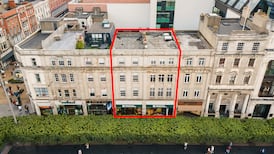It was all about 3D again this year but this time, it was personal, writes CIARA O'BRIENin Las Vegas
LOOKING AROUND the Consumer Electronics Show (CES) in Las Vegas, it was hard to imagine there was any ongoing difficulty in the world economy. Preliminary attendance figures indicate more than 140,000 industry professionals attended the event this year, with 30,000 coming from outside the US, a new record and the exhibition was thronged with people and 2,700 tech firms.
It was a turnaround from lower attendances that plagued the event in recent years.
“This global technology gathering featured more innovation, more news, more social media buzz and more international attendance than any other show in CES history,” said Gary Shapiro, president and chief executive of the Consumer Electronics Association.
Smartphones, 3D devices, tablets and smart televisions were the big themes at this year’s show. If it seemed like a bit of a rerun of 2010, that’s because the same themes appeared at the 2010 event. This year, however, the feeling is that there was more evolution. While the basic themes were the same, the technology was much more mature and developed.
With 3D high on the agenda, Sony’s big theme was making the technology personal. The company’s personal video camera range – Handycams and the Bloggie devices – Vaio laptops, and Cybershot digital still cameras will all be 3D enabled this year, allowing consumers to create their own 3D content.
It’s a path other companies are already following. Panasonic already has a 3D camcorder on the market and plans to expand it further. At CES, it announced more additions to that line up.
There was also a divergence in the type of 3D technology being pursued by companies. While Sony has gone the route of active 3D glasses, LG said it was exploring passive 3D which uses cheaper, lighter glasses.
Toshiba may follow a similar route in some territories, according to the head of its TV unit. Masaaki Osumi said sales of 3D models designed for use with special glasses had disappointed, accounting for only about 15-20 per cent of large TVs sold.
“We had wanted 3D sales to make up about half of large-screen TV sales, but it’s proving difficult,” he said. “The price premium for 3D TVs may still be too high. It’s the same in Japan, Europe and America. Sales of 3D TVs with glasses have not lived up to expectations.
“With 3D technology using glasses, the high price of glasses is a problem,” Osumi said. “We want to make the appropriate products for each region. If for example, passive became the main 3D technology in India, or was forecast to become so, we would pursue that aggressively.”
However, passive 3D technology is about as far as it goes. If the TV manufacturers have their way, the end of the TV as a passive device is nearing as they push the idea of “smart TVs” to consumers.
Sony and Panasonic are planning to bring additional functions to their smart TVs; LG meanwhile is enabling HDMI TVs to become smarter with the addition of a set-top box it unveiled early on at CES.
While the subject of tablet devices was broached at last year’s exhibition, this year they truly arrived.
It’s not hard to see why there has been such a push towards tablets. The segment is expected to more than triple to 50 million units in 2011, with Apple seen as by far the dominant company.
Kumu Puri, a senior executive with Accenture’s consumer electronics practice, said vendors cannot ignore tablet demand from corporate customers.
“If the traditional computer manufacturers aren’t thinking about how this is going to affect their line-up for the enterprise, they might end up holding the bag,” she said.
One of the challengers to Apple’s crown comes in the form of Google’s Android system, which was widespread at CES this year.
The Motorola Xoom was crowned the best gadget of CES 2011 by the official CNET Best of CES Awards. The 10.1-inch tablet uses Android’s new platform for tablets, Honeycomb, has two cameras and is Flash compatible.
But it had competition.
Blackberry’s Playbook also created a bit of a buzz, as the company aims its sights at the corporate market. The company tapped into another big trend of CES, by announcing a 4G version of its Playbook. This joined smartphone companies such as HTC and Samsung, unveiling Long Term Evolution (LTE) products that can take advantage of faster telecoms networks.
Lenovo, LG Electronics and Asustek Computer were among other companies showing off Android tablets at CES, while Dell unveiled a new seven-inch touchscreen Streak that will run on high-speed 4G networks.
Sony failed to show off any tablet device in its presentation, but promised that one was on the way.
“Android will be a key player in the tablet market but it will be hard for any single vendor to challenge Apple,” said Gartner analyst Carolina Milanesi.
Disappointingly, Microsoft failed to present any new tablet devices. Although the company announced it would develop a version of Windows that would support ARM chips, there was little in the way of surprises. At CES 2010, chief executive Steve Ballmer was extolling the virtues of tablet PCs, showing off the slates that would come throughout the year. This year, however, there were no landmark announcements.
Avatar Kinect, while an interesting addition to the game controller’s function list, wasn’t quite on a par with last year’s announcements. However, it did tap into a whole area of gesture control which was visible elsewhere on the floor at CES.
A number of companies were showcasing technology that allows you to control objects through voice and gestures.
“Control everything without touching it – it’s moving that way faster than ever,” said Janine Kutliroff, chief executive and founder of Omek Interactive, an Israeli company that makes software for gesture recognition through 3-D sensors, so you can play games or manipulate a TV just by moving your hands and body. Omek is helping pioneer “digital signage” – signs in stores that interact with shoppers and can initiate conversations when people walk close, or hover in an area.
The technology could pave the way for virtual sales assistants, provide virtual clothes-fitting, or aid physical rehabilitation by sending 3D images of a patient in real time to a remote therapist.
Elsewhere, despite the advent of tablet devices, e-readers aren’t dead in the water just yet. At the Showstoppers event, Entourage showed off its dual screen e-reader Edge, which combines an e-reader, tablet and notebook into one device.
Perhaps the biggest boost for the sector was the awarding of the “Last Gadget Standing” accolade to Barnes Noble’s NookColour reader. The award is voted for by consumers, with more than 60 per cent of the 5,000 votes cast online going to the device.
With so much on display, it was easy to see why the CEA is optimistic about the value of the electronics market. The challenge for these firms is to now translate the enthusiasm seen at the Las Vegas Convention Center into real sales.
– (Additional reporting: Reuters)









